DOI:
10.1590/1089-6891v18e-39597
ZOOTECNIA
CLIMATE SPATIALIZATION AND GENOTYPE-ENVIRONMENT INTERACTION
EFFECTS ON WEANING WEIGHTS OF NELLORE CATTLE IN EXTENSIVE SYSTEMS IN
TROPICAL REGIONS OF BRAZIL
EFEITOS DA ESPACIALIZAÇÃO CLIMÁTICA E INTERAÇÃO
GENÓTIPO-AMBIENTE SOBRE O PESO DA DESMAMA DE BOVINOS DA RAÇA NELORE
CRIADOS EM SISTEMAS EXTENSIVOS NO NORTE DO BRASIL.
Jorge Luis Ferreira1*
Fernando Brito Lopes2
José Américo Soares Garcia3
Maria Paula Beiriz Silva1
Leandro Lopes Nepomuceno4
Ednira Gleida Marques5
Marcelo Côrrea da Silva6
1Universidade Federal do Tocantins, Araguaína,
TO, Brazil.
2College of Agricultural & Life Sciences - University of
Wisconsin, Wiscosin, USA.
3Universidade de Brasília, Brasília, DF, Brazil.
4Universidade Federal de Goiás, Goiânia, GO, Brazil.
5Associação Brasileira de Criadores de Zebu - ABCZ, Uberaba,
MG, Brazil.
6Universidade Federal da Grande Dourados, Dourados, MS, Brazil.
*Author for correspondence - jlferreira@mail.uft.edu.br
Abstract
Depending on the environmental differences among the regions, the
phenotypic expression in beef cattle may significantly vary between the
progenies of the same sire, and this is an important rule to identify the
best animal. Thus, this study was carried out to spatialize environmental
factors that may help to compare and discriminate the states of Maranhão,
Pará, and Tocantins and also to check for genotype x environment
interaction (G x E interaction) in these regions. The environmental
variables analyzed were: maximum temperature; minimum temperature; mean
temperature; precipitation; normalized difference vegetation index;
relative humidity; altitude; and index of temperature and humidity.
Records of weaning weight of Nellore cattle raised on pasture were
collected between the years of 1997 and 2007. The dataset was constituted
of 21.117 animals, progenies of 161 sires. (Co)variance components and
breeding values were estimated using the multiple-trait derivative-free
restricted maximum likelihood method. Multivariate spatialization revealed
clear distinction among the States of Maranhão, Pará, and Tocantins and
allowed the identification of important environmental variables for
discrimination. The estimate for direct heritability showed moderate
magnitudes and were 0.22±0013, 0.26±0.021, and 0.29±0023, for the States
of Maranhão, Pará, and Tocantins, respectively. The estimates of
correlation between the breeding values, predicted in different States, as
well as the genetic correlation for weaning weight showed that sire ranks
changed among the States, indicating G x E interaction. There was a
variation of the genetic response of the progeny, depending on the sire
and on the State. Thus, the G x E interaction should be accounted for in
the genetic evaluation of sires and the performance of Nellore cattle
under extensive breeding systems in tropical regions of Brazil.
Keywords: animal breeding; canonical correlation;
cluster; heritability; Zebu.
Resumo
A expressão fenotípica pode variar significativamente sob diferenças
climáticas e deve ser um motivo de preocupação na identificação e seleção
de animais superiores no Brasil. Dessa forma, no presente estudo
objetivou-se espacializar fatores ambientais para discriminar os estados
do Maranhão (MA), Pará (PA) e Tocantins (TO) e verificar presença de
interação genótipo-ambiente (IGA) para peso ao desmame em rebanhos bovinos
da raça Nelore localizados nestes Estados. As variáveis ambientais
analisadas foram: temperatura máxima; temperatura mínima; temperatura
média; precipitação; índice vegetativo normalizado; umidade relativa;
altitude e índice de temperatura e umidade. Os registros de peso a desmama
de bovinos da raça Nelore criados à pasto foram coletados entre os anos de
1997 e 2007 e o conjunto de dados constituído por 21.117 animais, filhos
de 161 touros comuns aos Estados do MA, PA e TO. As estimativas para
herdabilidades direta apresentaram magnitudes moderadas, com valores de
0,22 ± 0,013 (MA), 0,26 ± 0,021(PA) e 0,29 ± 0,023 (TO). As variáveis
ambientais discriminaram bem os Estados e as estimativas revelaram
variação da resposta genética da progênie, dependendo do pai e do Estado
em questão. As estimativas de correlações genéticas para peso ao desmame
indicaram forte presença de interação genótipo-ambiente.
Palavras-chave: correlação canônica; cluster; herdabilidade;
produção animal; Zebu.
Received on January 28th, 2016.
Acceped on December 5th, 2016.
Introduction
The variation of environmental factors and effects is an
issue for cattle production in Brazil, considering the enormous magnitude
of beef production in this country. Meat production is associated to the
phenotype of animals, which is the relationship between genetic and
environmental components(1). Phenotypical expression may vary
significantly under climatic variation and should be a matter of concern
for the identification and selection of superior animals in Brazil(2,3).
Considering G x E interaction, Cooper and Dellacy(4) reported
that only when the genetic correlation among environments is less than one
does the G × E interaction restrain response to selection. In this sense,
different thresholds have been suggested to measure the significance of
this type of interaction(5). Frstly, however, it seems that
checking and discussing this phenomenon is the most fortunate way to
encourage the adoption of this approach in Brazil.
Climate and production systems vary significantly throughout the vast
tropical regions of Brazil. Therefore, consideration of G × E interaction
may impact significantly the efficiency of genetic improvement programs
over the years. An effort towards research on G × E interaction will come
up against several bottlenecks at the time of implementation. However,
when put into practice the advantage is that genetic evaluations are
delivered for each specific environment. This has been demonstrated in the
case of Nellore cattle breeding in several regions of Brazil(2,6-10).
The States of Maranhão, Pará, and Tocantins are considered a privileged
area to breed Nellore cattle under extensive pastures and tropical
conditions in South America, mainly because of the high sunlight incidence
and the soil conditions. The investigation was motivated under the
hypothesis that the large extent and heterogeneity of the Brazilian
landscape plays a role on the genetic evaluation of sires and the
performance of Nellore Cattle raised on pasture in tropical regions of
Brazil.
Materials and Methods
The analysis was scheduled and divided into two different
procedures. First, an ecologic characterization was undertaken to detect
environmental patterns of diversity. Second, a genotype x environment
interaction (G x E interaction) approach was carried out to verify any
environmental effect on both the phenotype and genotype of Nellore cattle.
The data set was composed of information describing the environmental
condition of 498 Brazilian cities distributed in the States of Maranhão
(217), Northeast of Brazil, Pará (143), and Tocantins (138), both located
in the North Region of Brazil (Figure 1). The States of Maranhão and
Tocantins are located in a transition zone between the Amazon and the
Savannah biome(11).
The environmental variables analyzed were the annual average for maximum
temperature (MAXT); minimum temperature (MINT); mean temperature (MT);
precipitation (PR); normalized difference vegetation index (NDVI);
relative humidity (RH); altitude (AL), and index of temperature and
humidity (ITH). All environmental variables were standardized by computing
the Z scores separately for each pair of States by standardizing
life-expectancy data to a mean of 0 and a standard deviation of 1(12).
Study variables (Table 1) were obtained by the Brazilian Institute of
Geography and Statistics, National Institute of Meteorology, National
Institute for Space Research, United States Geological Survey, and the
United Nations Program for Development.
The following multivariate analyses were used in this study: discriminant
analysis, which computes various discriminant functions for classifying
observations; canonical analysis, used to find linear combinations of the
quantitative variables that best summarize the differences among the
classes; and, stepwise selection, used to find a subset of quantitative
variables that reveal most of the differences among classes. Also, cluster
analysis was used to sort variables into groups which were not defined a
priori, so those objects in a given cluster tend to be similar to each
other in some sense, and objects in different clusters tend to be
dissimilar. Hierarchical clustering was performed using Ward's
minimum-variance method, in which the distance between two clusters is
based on the sum of squares between them added up over all the variables.
At each generation, the within-cluster sum of squares is minimized over
all partitions obtainable by merging two clusters from the previous
generation. To visualize the results from the cluster analysis, a
dendrogram was drawn (12).

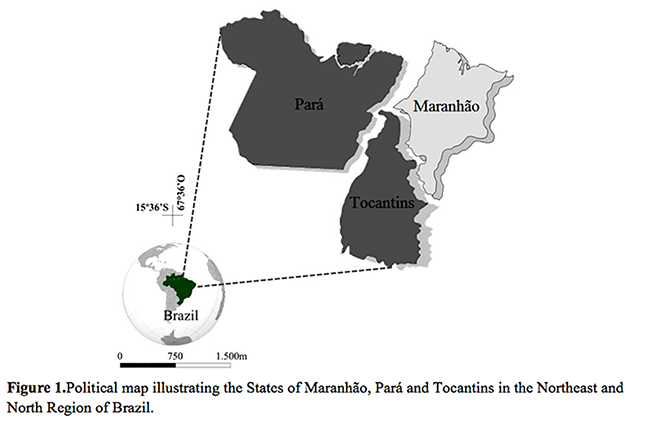
Performance records of 21,117 animals born in the states of Maranhão
(3.653), Pará (8.132), and Tocantins (9.332) from 1997 to 2007 were used
to study the effect of G x E interaction. Phenotypic data consisted of
standardized weights (205 days of age, W205) registered in the genetic
improvement program led by the Brazilian Association of Zebu Breeders
(ABCZ). The progenies included in the analysis were the offspring of 161
sires and 17.760 cows, bred in the States of Maranhão (2.966), Pará
(6.535), and Tocantins (8.159). The number of herds from each State was
142; 229; and 223, respectively. As exclusion criteria for males, only
sires that had progeny in all three States were included in the analysis.
The univariate and bivariate models included the random direct genetic
effects, with the maternal genetic effects and the maternal permanent
environmental effects, as well as the fixed effects of contemporary group
(herd, sex, season, and year of birth), and age of dam at calving as a
covariate (linear and quadratic effects). As suggested by Falconer and
Mackay(1), the expression of the same trait in two environments
can be considered as two different traits, and the genetic correlation
between them can be estimated in the same way as for any two correlated
traits, using bivariate analysis. To estimate genetic parameters for W205
the animal model was:
y=Xβ+Z1a+Z2m+Z3mpe+e
where, y is the vector of observations (W205); β is the vector of fixed
effects in the model, associated with the incidence matrix X; a is the
vector of random direct genetic effects associated with the incidence
matrix Z1; m is the vector of maternal genetic effects
associated with the incidence matrix Z2; mpe is the vector of
the random maternal permanent environmental effects associated with the
incidence matrix Z3; and, e is the vector of the random
residual effects.
The maternal and the direct genetic effects are assumed to be correlated,
while the residual and permanent environment effects are not, nor are they
correlated with the genetic effects. Computations of direct genetic (σa²),
maternal genetic (σm²,) covariance between the direct and
maternal genetic (σam), maternal permanent environmental (σmpe²,),
and residual variances (σe²) were carried out using the
MTDFREML software(13). The following (co)variance components
and parameters were calculated as in Willham(22): phenotypic
variance (σp² = σa²+σm²+σam+σpe²+σe²),
direct heritability (ha²=σa²/σp²), and
maternal heritability (hm²=σm²/σp²).
Breeding values were estimated using the Restricted Maximum Likelihood
Method - REML, with the MTDFREML software(13). The effect of G
x E interaction was also evaluated using the change in ranking of sires.
The sires were ranked based on their breeding values (BV) in each State.
The similarity between the rankings of sires in the three states was
evaluated using the Spearman correlation(12) considering the
BVs of the 161 bulls in each separate State.
Results
The multivariate discriminant analysis revealed that
discrimination between States is consistent, reinforcing the hypothesis
that phenotypical expression, concerning cattle production and
productivity, may be affected with different intensities throughout the
Brazilian landscape. The environmental variables used to characterize
climate conditions were enough to guarantee no misclassifications (0%)
when assigning any city into their respective State of origin (Table 2).

The environmental information revealed to be a real source of variation
between the States of Maranhão, Pará, and Tocantins, but some variables
where more important than others (p <0.05) (Table 3).

In parallel, the canonical analysis plot also made evident that the cities
from the same State group up together according to the similarity (Figure
2).
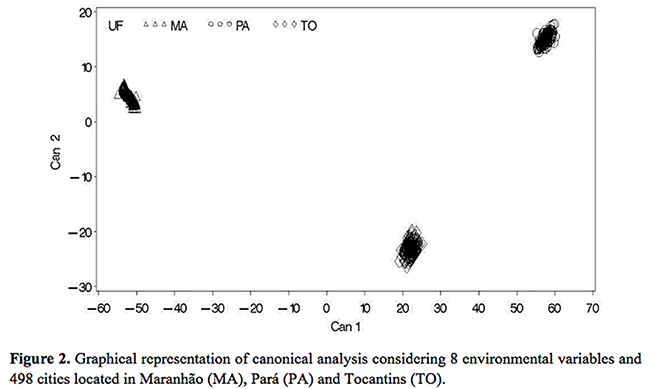
The distance between the clusters (Ward's Minimum-Variance Method) showed
that the difference between Maranhão and Pará is greater than the
difference between Maranhão and Tocantins (Figure 3).
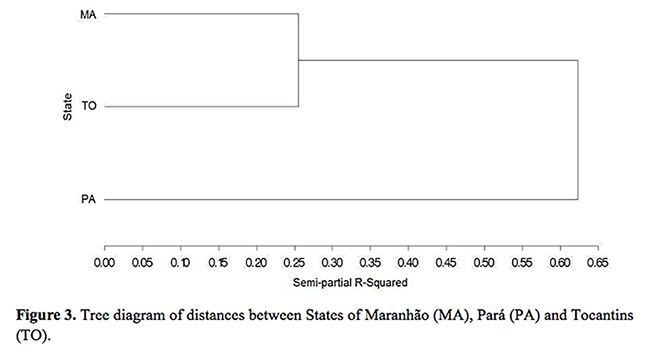
This result is probably due to the fact that the Amazon Forest is more
abundant in Pará than in Maranhão and Tocantins, which are both assigned
to the Cerrado Forest ecosystem. The canonical analysis was also able to
point out the variables that best discriminate the three States, which
presented strong correlation with TMAX, TMIN, and NDVI, respectively
(Figure 4).
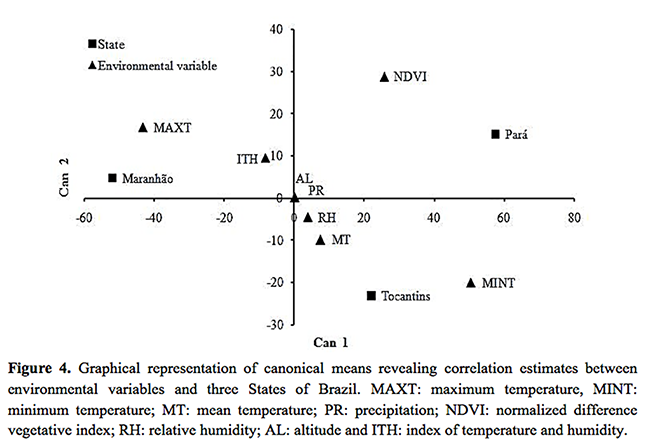
The multivariate analysis showed that the States of Maranhão, Pará, and
Tocantins have environmental peculiarities significant enough to reveal
strong discrimination. Under this condition, the selection of sires with
progeny in all three States was the subsequent step to verify
environmental influences on both the phenotype and genotype of the animals
raised in these regions. The estimates for direct heritability showed
moderate magnitudes and the weaning weights among the three States of
Brazil revealed to be different (P<0.01) (Table 4).
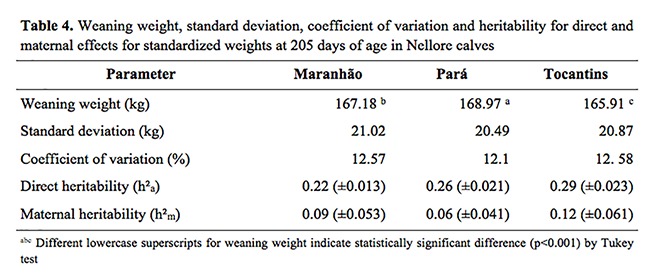
The difference in magnitude of these estimates is an indication that the
phenotypic response of the progeny of one sire depends on the political
region under evaluation. The maternal ability expresses the aptitude of
cows to care for their progeny. Besides being influenced by many factors,
this trait has great importance in breeding programs(2). The
estimates pointed low maternal heritability, indicating that maternal
ability suffers great influence of the environment effect and that the
performance of daughters of the same sire varies according to the State
under consideration. Assuming that the performance of sires varies when
exposed to different environments, the draw of the top 10% sires is
helpful to illustrate the variation on the expected performance of
progenies (Figure 5).

Estimated progeny difference (EPD) represent the divergence in the
expected performance of the progeny of one sire compared to other sires,
included in the same genetic evaluation program. Results in Figure 5
reinforce the statement that environmental diversity has been interfering
significantly in the genetic evaluation of Nellore sires in extensive
breeding systems in tropical regions of Brazil. It is also important to
pay attention that besides the correlations estimated using the top 10% of
sires are considered high, less than 20% of these sires where repeated.
Thus, such high correlations are due to similar trend, not due to
existence of the same sire, which were all ranked differently in each
State. As an example, the best sire in Tocantins (EPD = 12 kg and rank =
1º) had progenies only in Maranhão State (EPD = 1.04 kg and rank = 11º);
the best sire in Pará (EPD = 4.98 kg and rank = 1º) was found only in
Maranhão (EPD = 1.51 kg and rank = 5º); and, the best sire in Maranhão
(EPD = 1.97 kg and rank = 1º) had progenies in both States of Tocantins
(EPD = 6.61 kg and rank = 4º) and Pará (EPD = 3.40 kg and rank = 7º).
Ranking correlations between the breeding values of sires, predicted for
pairs of States, revealed the effect G x E interaction on selection for
weaning weight at 205 days (Table 5).
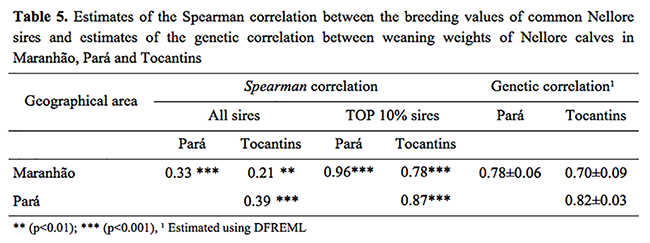
The magnitude of the genetic correlations between States was high (0.70 to
0.82) in all cases. In the absence of G x E interaction, the expected
genetic correlation across environments is one. In this sense, even using
the top 10% or all animals, the best bulls differ among the States. Ibi et
al.(5) suggested the G x E interaction is of biological and agricultural
importance if the genetic correlation for the same trait in different
environments is less than 0.80. With this threshold, only estimates of
genetic correlations for weaning weight were above the threshold of
biological importance of G x E interaction (Table 5). Thus, this provides
evidence that G x E interaction for this trait in the three States was
biologically significant enough to allow abundant re-ranking of animals
based on estimated breeding values (Figure 6).
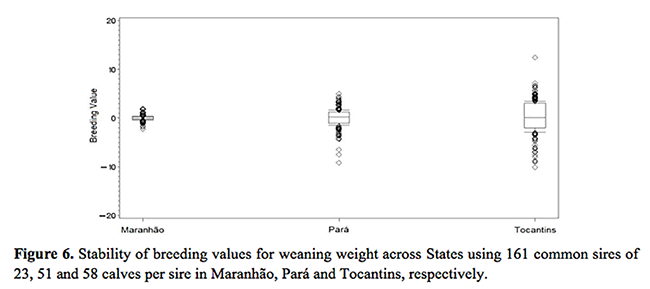
This indicates a limitation point for using weaning weight data from
different States in a nationwide genetic evaluation scheme based on
predicted breeding values because such approach leads to important changes
in the ranking of sires. The stability of breeding values for weaning
weight across all three States is illustrated in Figure 6 and is related
to the variability of the genotypes throughout different environments.
Discussion
The fine discrimination of States in terms of environmental
characteristics is a prior indication that, in some way, genetic and
phenotypic expression of Nellore cattle might be influenced by the
climatic conditions of the three States of Brazil. The environmental
peculiarities identified by the multivariate approach may be strongly
related to the genetic results, represented by changes in the relative
order of the ranking of sires among States. These results corroborate
Lopes et al.(2) and Toral et al.(7). In practice,
the implication is that a sire presenting satisfactory results for the
weaning weight of the progenies in one region may have poor performances
elsewhere. For this purpose, it would probably be necessary to carry out
separate breeding value estimates for sires in regions where ranking
variation is more intense. Small magnitudes of the Spearman correlation
estimates revealed little similarity of the ranking of sires among States.
The genetic correlation estimates were high, but not strong enough to
discard the assumption of G x E interaction. The presence of G x E
interaction means that inadequate selection of sires may occur if the
interaction effect is not accounted for. This is crucial considering that
genetic progress is dependent on the additive genetic effect of the
selected sires along generations. In the presence of G x E interaction,
the optimization of genetic improvement also requires consideration to the
stability of the sires selected for reproduction. The variation of the
breeding values among States (stability of sires) may be used as criteria
for the ranking and the selection of superior sires(14).
Stability is related to the variability of the genotypes throughout
different environments. Higher stabilities are associated to lower
environmental sensibility of the genotypes, which may help as a
conservative strategy for the selection of sires. Under G x E interaction,
sires that generate more similar progeny in different environments are
considered more stable. However, the selection of the steadiest genotypes
does not necessarily imply in better performance of the progeny (weaning
weights) in all environments. Animal performance can be affected by G x E
interaction and environmental sensitivity(3,15-17). The
accuracy of the selection process depends on adjusting selection criteria
to local environment effects(18). So, estimating environmental
effects on productive traits reduces information bias and improves the
accuracy of the results. But most importantly, it is essential to generate
higher production levels, consistent and appropriate to the local
circumstance. Adjusting genetic material to the local environmental
conditions can be considered as an effort towards more sustainable
production systems. This more holistic approach may have positive
consequences in the differentiation of breeding goals(16).
Considering the increased privatization scenario of breeding companies and
the amplified trade of breeding stock, empowered by globalization, the
differentiation in breeding goals may play an important role on the
maintenance of worldwide genetic variability in domestic animals(19).
Not only the present heterogeneity of production circumstances are in
concern, but also the uncertainty and the associated risk about future
circumstances, like global warming. Climate characterization and G x E
interaction appraisals may help to encourage and map the differentiation
of breeding goals and the maintenance of diverse breeding stocks(20).
Concepts of stability, efficiency, and performance have been reported
repeatedly in the debate concerning genetic improvement strategies and the
success of breeding programs in diversifying environments(16,21).
However, the debate still stands on the fact that most breeding programs
aim for improvements in productivity(15), apparently
disregarding the fact that the success of these programs require also the
consideration of environmental traits(3). To overcome this impasse, animal
breeding programs should be designed to account for a more satisfactory
level of factors that may influence animal production across the regions
of Brazil(3).
Conclusion
The environmental components were important and sufficient
to reveal fine discrimination among the States of Maranhão, Pará, and
Tocantins. This emphasizes the climatic specificity and diversifying
conditions of the tropical extensive systems where Nellore cattle are
produced in Brazil. The identification of genotype x environment
interaction for weaning weights is appealing for the consideration of this
effect on the genetic evaluation of sires in Brazil.
Acknowledgements
The authors are grateful to the Federal University of
Tocantins (Financial support process Propesq/UFT No. 21/2014), the
Brazilian Association of Zebu Breeders (ABCZ), the Brazilian Institute of
Geography and Statistics, the National Institute of Meteorology, the
National Institute for Space Research and the United States Geological
Survey for the phenotypic and environmental datasets provided for this
study.
References
1. Falconer DS, Mackay TFC. Introduction to quantitative
genetics. Longmans Green: Harlow, 1996. 386.
2. Lopes JS, Rorato PRN, Weber T, Boligon AA, Comin JG, Dornelles MDA.
Efeito da interação genótipo x ambiente sobre o peso ao nascimento, aos
205 e aos 550 dias de idade de bovinos da raça Nelore na Região Sul do
Brasil. Revista Brasileira de Zootecnia. 2008;37(1), 54-60.
3. McManus C, Cobuci J, Braccini Neto J, Paiva S. Decision making in
animal breeding programs and their consequences for animal production.
Revista Brasileira de Reprodução Animal. 2011;35(2), 69-76.
4. Cooper M,Delacy IH. Relationships among analytical methods used to
study genotypic variation and genotype-by-environment interaction in plant
breeding multi-environment experiments. Theoretical and Applied Genetics.
1994;88(5), 561-572.
5. Ibi T, Hirooka H, Kahi AK, Sasae Y, Sasaki Y. Genotype× environment
interaction effects on carcass traits in Japanese Black cattle. Journal of
animal science. 2005;83(7), 1503-1510.
6. Ferreira VC, Penna VM, Bergmann JA, Torres RA. Interaçäo
genótipo-ambiente em algumas características produtivas de gado de corte
no Brasil. Arquivo Brasileiro de Medicina Veterinária e Zootecnia.
2001;53(3), 385-392.
7. Toral FLB,Silva LOC,Martins EN. Interação genótipo x ambiente em
características de crescimento de bovinos da raça Nelore no Mato Grosso do
Sul. Revista Brasileira de Zootecnia. 2004;33(6), 1445-1455.
8. Alencar MM,Mascioli AS,Freitas AR. Evidências de interação genótipo -
ambiente sobre características de crescimento em bovinos de corte. Revista
Brasileira de Zootecnia. 2005;34(2), 489-495.
9. de Almeida Teixeira R, de Albuquerque LG, de Alencar MM, Dias LT.
Interação genótipo-ambiente em cruzamentos de bovinos de corte. Revista
Brasileira de Zootecnia. 2006;35(4), 1677-1683.
10. Fridrich AB, Silva MA, Valente BD, Sousa JE, Corrêa GS, Ferreira IC,
Ventura RV, Silva LO. Interação genótipo x ambiente e estimativas de
parâmetros genéticos dos pesos aos 205 e 365 dias de idade de bovinos
Nelore. Arquivo Brasileiro de Medicina Veterinária e Zootecnia.
2008;60(4), 917-925.
11. IBGE - Instituto Brasileiro de Geografia e Estatística. Censo
Agropecuário, Available in: http:
www.ibge.gov.br Access in: August.2014;28.
12. SAS Institute Inc. Statistical Analysis System user’s guide. SAS
Institute Press, 2002, USA. Disponível em https://support.sas.com/documentation/cdl/en/statugintroduction/61750/PDF/default/statugintroduction.pdf.
13. Boldman KG,Kriese LA,Van Vleck LD. A manual for use for MTDFREML. A
set of programs to obtain estimates of variance and covariance [DRAFT].
1995. Lincoln: Department of Agriculture/Agricultural Research Service.
Disponível em :https://www.researchgate.net/profile/Lloyd_Van_Vleck/publication/281307227_A_Manual_for_Use_of_MTDFREML__a_Set_of_Programs_to_Obtain_Estimates_of_Variances_and_Covariances_draft/links/55e5f48808aebdc0f58ba17.pdf
. Acesso em novembro de 2016
14. Lin CH, Togashi K. Genetic improvement in the presence of genotype by
environment interaction. Journal Animal Science. 2002;73(1), 3-11.
15. Blackburn H,Lebbie SHB,Van De Zijpp AJ. Animal Genetic Resources and
sustainable development. In: world congress on genetics applied to
livestock production, 6, 1998, Armidale, Proceedings..., UNE, 6 WCGALP/FAO
Symposium. 1998;28, 3-10.
16. Olesen I,Goren AF,Gjerde B. Definition of animal breeding goals for
sustainable production systems. Journal Dairy Science. 2000;78(3, 570-582.
17. Pegolo NT. Interação genótipo-ambiente e sensibilidade ambiental em
bovinos de corte. Ribeirão Preto, 2009. 115 p. (PhD Thesis) - Faculdade de
Medicina de Ribeirão Preto, Universidade de São Paulo, Ribeirão Preto, SP.
Disponível em
http://repositorio.unesp.br/bitstream/handle/11449/95335/pegolo_nt_me_botfmvz.pdf?sequence=1
18. Dal-FARRA RA,Roso VM,Schenkel FS. Efeitos de ambiente e heterose sobre
o ganho de peso do nascimento ao desmame e sobre os escores visuais ao
desmame de bovinos de corte. Revista Brasileira de Zootecnia. 2002;31(3),
1350-1361.
19. Hammond K. The status, state and conservation of animal genetic
resources. FAO, Rome (Mimeo) 1993. 86.
20. Smith C. Genetic aspects of conservation in farm livestock. Livestock
Production Science. 1984;11(6), 37-48.
21. Espasandin AC, Urioste JI, Campos LT, Alencar MMD. Genotype × country
interaction for weaning weight in the Angus populations of Brazil and
Uruguay. Revista Brasileira de Zootecnia. 2011;40(3), 568-574.
22. Willham RL. The role of maternal effects in animal breeding: III.
Biometrical aspects of maternal effects in animals. J Anim Breed Genet.
1972;35: 1288–1293.